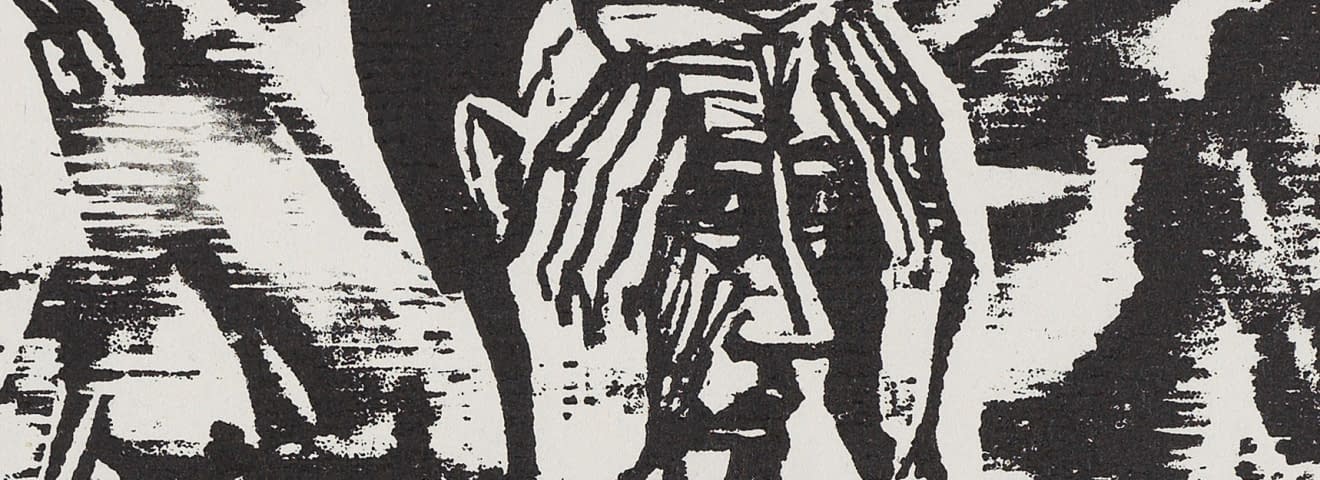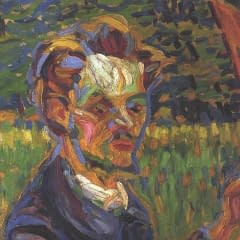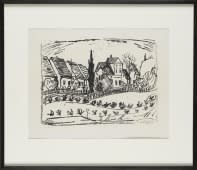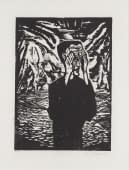Erich Heckel
né(e) le 13. juillet 1883 à Döbeln
décédé(e) le 27. novembre 1970 à Radolfzell am Bodensee
Style artistique
À propos
Erich Heckel begann 1904 ein Architekturstudium in Dresden, wo er Ernst Ludwig Kirchner und Fritz Bleyl kennenlernte. Bereits 1905 brach er das Studium wieder ab und entschloss sich für eine autodidaktische Laufbahn als Künstler. Im Juni desselben Jahres gründete er mit Kirchner, Beyl und Karl Schmidt-Rottluff in Dresden die Künstlergruppe Die Brücke.
1937 wurde ein Ausstellungsverbot für Heckels Werke ausgesprochen. Im Zuge der Aktion «Entartete Kunst» fielen zahlreiche seiner Arbeiten Verbrennungen und Zerstörungen zum Opfer. 1944 fand Heckel Zuflucht in Hemmenhofen am Bodensee. Nach Kriegsende erhielt er verschiedene Aufforderungen nach Berlin zurückzukehren und ein Lehramt an der Hochschule der Künste zu übernehmen, doch lehnte er ab und blieb bis zu seinem Lebensende in Hemmenhofen.
Erich Heckels früher Stil zeigt Einflüsse von Vincent van Gogh und dem französischen Post-Impressionismus. Ab 1908 kann jedoch ein Übergang zu einer flächigen Malerei festgestellt werden. Um 1910 ist ein ausgeprägter Gruppenstil, gekennzeichnet durch grobe, kantige Formen und eine intensive Farbgebung, erreicht, den Heckel jedoch nach der Auflösung der Brücke wieder aufgibt.
Nach dem Ersten Weltkrieg entwickelte sich in Heckels Arbeiten eine naturalistische Klassizität, geprägt durch eine vorwiegend helle Farbpalette. Das Landschaftsaquarell wird zur bevorzugten Gattung für den Künstler und es entstehen zahlreiche Städte- und Hafenbilder. Parallel widmet er sich kontinuierlich auch Aktdarstellungen am Strand, ein Thema, das den Künstler bis in die 1930er Jahre beschäftigte.
Erich Heckel (1883, Döbeln – 1970, Radolfzell by Lake Constance) began studying architecture in Dresden in 1904, where he met Ernst Ludwig Kirchner and Fritz Bleyl. In 1905, he broke off his studies and decided to pursue an autodidactic career as an artist. In the month of June 1905, he founded the artists' group Die Brücke in Dresden with Kirchner, Beyl, and Karl Schmidt-Rottluff.
In 1937, Heckel's works were banned from exhibition in Germany. During the "Degenerate Art" campaign, many of his works fell victim to mass-incinerations and destruction conducted at the time. In 1944, Heckel found refuge in Hemmenhofen by Lake Constance. After the end of the war, he received various invitations to return to Berlin and to take up a teaching post at the Hochschule der Künste, he refused and remained in Hemmenhofen until the end of his life.
Erich Heckel's early style displays influences from Vincent van Gogh and French Post-Impressionism. From 1908 onwards, a transition to two-dimensional painting can be detected. Around 1910, a new discernable style, characterized by rough, angular forms and an intense use of colour, was developed by the group; Heckel abandoned this new style after the dissolution of the Brücke. In printmaking, Heckel displayed a high level of independence early on, and a selection of his woodcuts are now considered to be among the strongest achievements of German Expressionism.
After World War I, a naturalistic Classicism developed in Heckel's works, characterized by a predominantly light colour palette. The landscape watercolour became the preferred genre of the artist, and he produced numerous city and harbour paintings during that time. Nonetheless, he continuously devoted himself to nudes on the beach, a theme that occupied the artist’s work until the 1930s.
Ausstellungen (Auswahl)
2017/2018 Collector's Choice: Deutscher Expressionismus, Bromer Kunst, Roggwil.
2016 Erich Heckel. 120 WERKE, Museum Gunzenhauser, Chemnitz.
2013 Erich Heckel. Der große Expressionist, Stadthalle Balingen.
1994 Erich Heckel. Aquarelle, Zeichnungen Druckgraphik, Bündner Kunstmuseum Chur.
1937 wurde ein Ausstellungsverbot für Heckels Werke ausgesprochen. Im Zuge der Aktion «Entartete Kunst» fielen zahlreiche seiner Arbeiten Verbrennungen und Zerstörungen zum Opfer. 1944 fand Heckel Zuflucht in Hemmenhofen am Bodensee. Nach Kriegsende erhielt er verschiedene Aufforderungen nach Berlin zurückzukehren und ein Lehramt an der Hochschule der Künste zu übernehmen, doch lehnte er ab und blieb bis zu seinem Lebensende in Hemmenhofen.
Erich Heckels früher Stil zeigt Einflüsse von Vincent van Gogh und dem französischen Post-Impressionismus. Ab 1908 kann jedoch ein Übergang zu einer flächigen Malerei festgestellt werden. Um 1910 ist ein ausgeprägter Gruppenstil, gekennzeichnet durch grobe, kantige Formen und eine intensive Farbgebung, erreicht, den Heckel jedoch nach der Auflösung der Brücke wieder aufgibt.
Nach dem Ersten Weltkrieg entwickelte sich in Heckels Arbeiten eine naturalistische Klassizität, geprägt durch eine vorwiegend helle Farbpalette. Das Landschaftsaquarell wird zur bevorzugten Gattung für den Künstler und es entstehen zahlreiche Städte- und Hafenbilder. Parallel widmet er sich kontinuierlich auch Aktdarstellungen am Strand, ein Thema, das den Künstler bis in die 1930er Jahre beschäftigte.
Erich Heckel (1883, Döbeln – 1970, Radolfzell by Lake Constance) began studying architecture in Dresden in 1904, where he met Ernst Ludwig Kirchner and Fritz Bleyl. In 1905, he broke off his studies and decided to pursue an autodidactic career as an artist. In the month of June 1905, he founded the artists' group Die Brücke in Dresden with Kirchner, Beyl, and Karl Schmidt-Rottluff.
In 1937, Heckel's works were banned from exhibition in Germany. During the "Degenerate Art" campaign, many of his works fell victim to mass-incinerations and destruction conducted at the time. In 1944, Heckel found refuge in Hemmenhofen by Lake Constance. After the end of the war, he received various invitations to return to Berlin and to take up a teaching post at the Hochschule der Künste, he refused and remained in Hemmenhofen until the end of his life.
Erich Heckel's early style displays influences from Vincent van Gogh and French Post-Impressionism. From 1908 onwards, a transition to two-dimensional painting can be detected. Around 1910, a new discernable style, characterized by rough, angular forms and an intense use of colour, was developed by the group; Heckel abandoned this new style after the dissolution of the Brücke. In printmaking, Heckel displayed a high level of independence early on, and a selection of his woodcuts are now considered to be among the strongest achievements of German Expressionism.
After World War I, a naturalistic Classicism developed in Heckel's works, characterized by a predominantly light colour palette. The landscape watercolour became the preferred genre of the artist, and he produced numerous city and harbour paintings during that time. Nonetheless, he continuously devoted himself to nudes on the beach, a theme that occupied the artist’s work until the 1930s.
Ausstellungen (Auswahl)
2017/2018 Collector's Choice: Deutscher Expressionismus, Bromer Kunst, Roggwil.
2016 Erich Heckel. 120 WERKE, Museum Gunzenhauser, Chemnitz.
2013 Erich Heckel. Der große Expressionist, Stadthalle Balingen.
1994 Erich Heckel. Aquarelle, Zeichnungen Druckgraphik, Bündner Kunstmuseum Chur.










